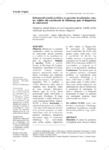Mostrar o rexistro simple do ítem
Enfermedad arterial periférica en pacientes trasplantados renales: validez del cuestionario de Edimburgo para el diagnóstico de enfermedad
| dc.contributor.author | Lema Verdía, María Laura | |
| dc.contributor.author | Balboa-Barreiro, Vanesa | |
| dc.contributor.author | Couceiro Sánchez, Estefanía | |
| dc.contributor.author | González-Martín, Cristina | |
| dc.contributor.author | Pértega-Díaz, Sonia | |
| dc.contributor.author | Seoane-Pillado, Teresa | |
| dc.contributor.author | Pita-Fernández, Salvador | |
| dc.date.accessioned | 2021-09-27T10:45:22Z | |
| dc.date.available | 2021-09-27T10:45:22Z | |
| dc.date.issued | 2021-06-22 | |
| dc.identifier.citation | Lema-Verdía L, Balboa Barreiro V, Couceiro Sánchez E, González-Martín C, Pértega-Díaz S, Seoane-Pillado T, et al. Enfermedad arterial periférica en pacientes trasplantados renales: validez del cuestionario de Edimburgo para el diagnóstico de enfermedad. Rev Nefrol Dial Traspl. 2021;41(2):100-12 | es_ES |
| dc.identifier.issn | 0326-3428 | |
| dc.identifier.uri | http://hdl.handle.net/2183/28516 | |
| dc.description.abstract | [Resumen] Objetivos: Determinar en pacientes trasplantados renales la prevalencia de enfermedad arterial periférica y la validez de las manifestaciones clínicas de claudicación intermitente para su diagnóstico. Material y métodos: Ámbito y período: Servicio de Nefrología del Complejo Hospitalario Universitario A Coruña, 2013-2017. Criterios inclusión: pacientes trasplantados renales con injerto funcionante que consientan participar en el estudio. Justificación del tamaño muestral: n=371 pacientes (seguridad= 95% y precisión= ± 4,25%). Mediciones: edad, edad al trasplante, sexo, dislipemia, índice de masa corporal, tabaquismo, diabetes, signo de Godet, edema perimaleolar, índice tobillo-brazo y cuestionario Edimburgo. El riesgo cardiovascular se midió mediante los scores Framingham-Wilson, Regicor, SCORE y Dorica. Resultados: La edad media al trasplante fue de 47,86 ± 12,62 años, 65,5% hombres. El 8,7% de los pacientes presentan un índice tobillo-brazo <0,90. El 16,2% de los pacientes manifiestan claudicación intermitente según el cuestionario Edimburgo. La concordancia entre ambas pruebas diagnósticas es débil (índice de Kappa=0,34). El cuestionario de Edimburgo mostró sensibilidad del 59,38% para predecir índice tobillo-brazo <0,90 y especificidad del 88,10%. Las variables asociadas a la presencia de arteriopatía son la edad al trasplante (OR=1,07) y el tabaquismo (OR=6,17), encontrándose la dislipemia en el límite de la significación estadística. Conclusiones: Una décima parte de los pacientes presentan arteriopatía periférica. La concordancia entre el cuestionario Edimburgo y el índice tobillo-brazo es débil. Por lo que debería usarse el índice tobillo-brazo como método diagnóstico. Las manifestaciones clínicas infraestiman la prevalencia de arteriopatía. La edad, el tabaquismo y la dislipemia incrementan su riesgo. Los pacientes con arteriopatía presentan riesgo cardiovascular más elevado. | es_ES |
| dc.description.abstract | [Abstract] Objectives: To assess the prevalence of peripheral artery disease in kidney transplant patients and the validity of intermittent claudication for its diagnosis. Methods: Setting and period: Nephrology Department of the University Hospital A. Coruña, 2013-2017. Inclusion criteria: transplant patients with functioning grafts who gave their consent to participate in the study. Sample size rationale: n=371 patients (confidence interval= 95%; precision= ± 4.25%). Measurements: age, age at the time of transplant, sex, dyslipemia, body mass index, smoking, diabetes, sign of Godet, perimalleolar edema, ankle-brachial index and the Edinburgh Questionnaire. Cardiovascular risk was measured with these scores: Framingham-Wilson, Regicore, SCORE and Dorica. Results: The mean age at the time of transplant was 47.86±12.62; 65.5% of patients were men and 8.7% of them had an ankle-brachial index of <0.90. When answering the Edinburgh Questionnaire, 16.2% of subjects reported suffering from intermittent claudication. Concordance between these two diagnostic tests is poor (kappa index= 0.34). The Edinburgh Questionnaire showed a sensitivity of 59.38% in predicting the ankle-brachial index (<0.90) and specificity (88.10%). The variables associated with the presence of artery disease are age at the time of transplant (OR=1.07) and smoking (OR=6.17), dyslipidemia being at the limit of statistical significance. Conclusions: A tenth part of the patients have peripheral artery disease. Concordance between the Edinburgh Questionnaire and the ankle-brachial index is poor; therefore, the latter should be used as diagnostic method. Clinical signs and symptoms underestimate the prevalence of artery disease. Age, smoking and dyslipidemia increase the risk of this disease. Artery disease patients have a higher cardiovascular risk. | es_ES |
| dc.language.iso | spa | es_ES |
| dc.publisher | Asociación Nefrológica de Buenos Aires | es_ES |
| dc.relation.uri | http://www.revistarenal.org.ar/index.php/rndt/article/view/646 | es_ES |
| dc.rights | Creative Commons Attribution-NonCommercial 4.0 International License (CC-BY-NC 4.0) | es_ES |
| dc.rights.uri | http://creativecommons.org/licenses/by-nc/4.0/ | * |
| dc.subject | Índice tobillo-brazo | es_ES |
| dc.subject | Cuestionario Edimburgo | es_ES |
| dc.subject | Claudicación intermitente | es_ES |
| dc.subject | Enfermedad arterial periférica | es_ES |
| dc.subject | Riesgo cardiovascular | es_ES |
| dc.subject | Ankle-brachial index | es_ES |
| dc.subject | Edinburgh questionnaire | es_ES |
| dc.subject | Intermittent claudication | es_ES |
| dc.subject | Peripheral arterial disease | es_ES |
| dc.subject | Cardiovascular risk | es_ES |
| dc.title | Enfermedad arterial periférica en pacientes trasplantados renales: validez del cuestionario de Edimburgo para el diagnóstico de enfermedad | es_ES |
| dc.type | info:eu-repo/semantics/article | es_ES |
| dc.rights.access | info:eu-repo/semantics/openAccess | es_ES |
| UDC.journalTitle | Revista de Nefrología, Diálisis y Trasplante | es_ES |
| UDC.volume | 41 | es_ES |
| UDC.issue | 2 | es_ES |
| UDC.startPage | 100 | es_ES |
| UDC.endPage | 112 | es_ES |
Ficheiros no ítem
Este ítem aparece na(s) seguinte(s) colección(s)
-
INIBIC-ECB - Artigos [50]






